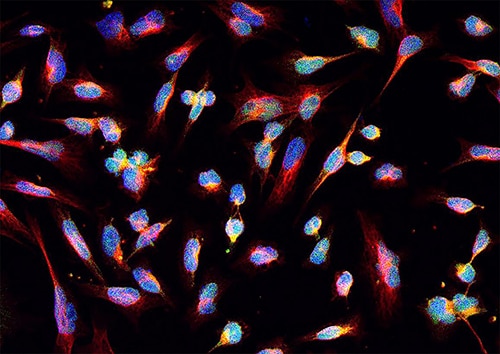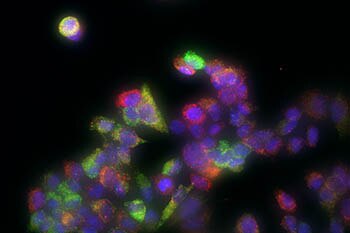Research Updates
New genetic repeat expansion disease identified: An international collaboration that includes NIDDK researchers has identified a rare genetic disorder caused by a small region of DNA that has become repeated many more times than it should be, a phenomenon called repeat expansion. In this case, the repeat expansion is located in a non-coding region of the GLS gene and results in a reduction in the body’s ability to make glutamate, a vital neurotransmitter in the brain. This causes developmental delays and severe ataxia, or problems with balance and walking, in people with the condition.
After whole genome sequencing failed to identify a causative mutation, the team used new software tools that suggested the presence of an expansion at the beginning of the GLS gene. This was verified using a novel repeat PCR assay developed at NIDDK and the expansion was confirmed as the cause of the disorder through additional clinical data collection and functional tests. In addition to helping the diagnosis and search for treatments to this disorder, this research may also provide important clues in understanding other repeat expansion diseases, such as Huntington disease and Fragile X syndrome. The study was published in April in The New England Journal of Medicine.

Coronary artery wall thickness measured by MRI is a marker of heart disease risk in women: NIH researchers and collaborators have found that coronary vessel wall thickness as measured by a refined method of cardiac MRI is a marker for cardiac disease in women. The researchers enrolled asymptomatic men and women at low or intermediate risk for coronary artery disease (CAD) based on the traditional Framingham Risk Score, which uses age, sex, blood pressure, cholesterol, and other factors to predict heart disease risk. They used MRI to visualize the thickness of the coronary artery wall that is associated with the amount of plaque in the coronary artery and compared these results to a traditional CAD assessment method called coronary computerized tomography angiography. They found that for women, vessel wall thickness was more strongly associated with CAD than any other factor. For men, their risk was strongly associated with age. The results, published in April in Radiology: Cardiothoracic Imaging, point to a potential future role for vessel wall thickness measurements in identifying opportunities for early lifestyle changes or treatment in younger asymptomatic women.

Study confirms lasting effects of low-dose anti-thymocyte globulin in newly diagnosed type 1 diabetes: Researchers from Type 1 Diabetes TrialNet found that low-dose anti-thymocyte globulin (ATG) slowed the decline in insulin production and improved long-term blood glucose control for two years in people newly diagnosed with type 1 diabetes. ATG acts to suppress the immune system and is approved by the Food and Drug Administration (FDA) for prevention and treatment of kidney transplant rejection. TrialNet researchers wanted to know if ATG alone or in combination with pegylated granulocyte colony stimulating factor (GCSF, Neulasta®), an FDA-approved drug used to increase white blood cell counts in people receiving chemotherapy, could slow insulin loss when started soon after diagnosis. Researchers enrolled 89 children and adults, ages 12-42, with newly diagnosed type 1 diabetes in a three-arm clinical trial. One group received a single course of ATG; another group received a single course of ATG, followed by treatment with GCSF; and the control group received placebo. Two years after treatment, those who received ATG alone had a slower decline in insulin production compared to those who received placebo, supporting similar results reported after the first year. The groups receiving ATG and ATG plus GCSF also had improved long-term blood glucose control compared to the placebo group. The study was published in Diabetes in April.
Diabetes relief in mice by glucose-sensing, insulin-secreting human alpha cells: Human pancreatic cells change their function in the absence of insulin-secreting beta cells, according to new NIDDK-funded research from the Human Islet Research Network. From donor islets, researchers isolated and separated two pancreatic cell types – alpha cells, which secrete the hormone glucagon, and gamma cells, which produce pancreatic polypeptide protein. They then added two critical transcription factors necessary for insulin production – PDX1 and MAFA – to each cell culture. The team found that PDX1 and MAFA transcription factors caused the alpha and gamma cells to produce insulin in the presence of glucose – an effect observed in vitro, as well as when the cells were implanted in diabetic mice with no beta cells. The reprogrammed alpha cells were also less susceptible to type 1 diabetes autoimmunity. These findings, published in Nature in February, suggest potential therapeutic applications for people with type 1 diabetes.

Study unveils a blueprint for treating a deadly brain tumor: People with low-grade gliomas whose tumors have mutations in isocitrate dehydrogenase 1 (IDH1) are typically younger and live longer than those who have the normal version of the gene, according to NIH-funded research. These tumors also often have mutations in the tumor suppressor protein 53 (TP53) gene, and the alpha thalassemia/mental retardation syndrome X-linked gene (ATRX). To explore ways to treat gliomas with IDH1 mutations and to understand why this combination of mutations makes the tumors difficult to treat, researchers genetically engineered mice to grow brain cancer cells with the disease-causing mutations in IDH1 along with mutations in TP53 and ATRX. The IDH1 mutation made the mouse tumors less aggressive but also caused changes that increased the manufacture of proteins known to repair damaged DNA, making them resistant to radiation therapy, which often kills cells by damaging DNA. The researchers then found that these mice became sensitive to radiation therapy if they were exposed to compounds designed to block DNA repair. By doing so, radiation therapy was more effective and extended survival. The researchers are now planning a phase I clinical trial to test the safety and efficacy of the combination therapy strategy developed in the study. The research, published in February in Science Translational Medicine, was partially supported by a NIH Common Fund Metabolomics Program grant to University of Michigan Regional Comprehensive Metabolomics Resource Core.
NIDDK-funded research network discovers a genetic defect linked to pediatric liver disease: Mutations of the PKD1L1 gene were present in a subset of children with a complex form of biliary atresia (BA) participating in the Childhood Liver Disease Research Network (ChiLDReN), according to a new study. BA is the most common cause of pediatric end-stage liver disease and liver transplantation. BA’s cause is unknown, making this an important discovery to determine the underlying mechanisms of the condition and develop therapeutic alternatives. Using next-generation sequencing technology, ChiLDReN researchers looked at more than 2,000 genes and plan to expand the analysis to other genes. The research was published in Hepatology in January.
New technology assists personalized insulin titration: For people with diabetes who take insulin, the amount of insulin they need to reach their glycemic goals is usually determined by a health care professional during checkups. In a study published in The Lancet in March, research funded by the NIH Small Business Technology Transfer Program evaluated the d-Nav Insulin Guidance System, which is a handheld glucose meter that saves the user’s blood glucose values over time and applies an algorithm to calculate the next insulin dose. Researchers found that after 6 months, people using the d-Nav device combined with regular healthcare professional support had greater improvements in glycemic control than the comparison group, which used regular glucose meters and health care professional support. The intervention group using the dNav devices had more frequent adjustments in insulin doses than the comparison group. While both groups had the same frequency of hypoglycemic events, the blood glucose values were not as low in the intervention group. The Food and Drug Administration approved a dNav insulin titration application for smartphones in February.

Intrinsic dynamics of a human gene reveal the basis of expression heterogeneity: To better understand how genes regulate the transcription process in cells, NIH researchers used live time-lapse imaging to study activation of the TFF1 gene in response to estrogen in human breast cancer cells. The estrogen response in breast tissue is well-characterized, but exactly how estrogen triggers the internal response of the cell is unknown. The researchers observed in real time that estrogen-responsive TFF1 transcription was variable among alleles within the same cell, with some having long periods of inactivity lasting more than 12 hours, while other alleles were active. The different alleles, however, did not act independently, as activity of one allele made the activation of another allele more likely. Based on their observations, the team developed a mathematical model of the dynamics of the internal TFF1 transcriptional activity of the human cell. The authors note that the transcriptional variability observed in TFF1 could be based on its functional role and may not be representative of other functional gene groups. This work was published in Cell in January.
Drug rescues in utero and postnatal multi-organ disease in a ferret model of cystic fibrosis: Researchers previously developed a large mammalian model for cystic fibrosis (CF) in ferrets, missing the CFTR gene, with high similarity to human disease. Large animal models in the ferret and pig resemble human cystic fibrosis, but high mortality rates due to early life gut and pancreatic manifestations of disease have limited their utility. The ferret CF model has now been modified to express ferret CFTR containing the human CF mutation G551D. By incorporating in utero and early life treatment of the CFTRG551D ferrets with the drug VX-770 (ivacaftor), newborn ferrets had fewer complications at birth and improved survival. VX-770 is Food and Drug Administration-approved to treat people with CF who express the G551D mutation. The researchers showed that treatment with VX-770 during pregnancy and after birth is effective at reducing early life CF-related pathologies. This new CF model may provide critical insight into the neonatal and early life natural history of human CF in future research and illuminate a potential path to prevention. The research was published in Science Translational Medicine in March.
Data sharing enhances understanding of Alzheimer’s risk: Analysis of genetic data from more than 94,000 individuals revealed five new risk genes for Alzheimer’s disease and confirmed 20 known others. An international team of researchers also reports that mutations in genes specific to tau, a hallmark protein of Alzheimer’s disease, may play an earlier role in the development of the disease than originally thought. These new findings support developing evidence that groups of genes associated with specific biological processes, such as cell trafficking, lipid transport, inflammation and the immune response, are “genetic hubs” that are an important part of the disease process. The NIH-funded study is part of the International Genomic Alzheimer’s Project and builds on earlier results. The research was published in February in Nature Genetics.
Scientists investigate using A3 adenosine receptor agonists to treat pain: Research by NIDDK scientists and others, published in January in the journal PAIN, showed how a drug can activate a spinal cord receptor to suppress pain signaling. The drug, which was invented by NIDDK researchers, is a type of A3 adenosine receptor agonist that controls pain by blocking a type of calcium channel in the spinal cord. The drug can be given orally, while other drugs with a similar effect are currently only available as spinal injections. Although research has not yet been done in humans, investigators hope that nonopioid drug therapies like these could one day be used as nonaddictive treatment for chronic pain.

Weekend catch-up sleep doesn’t make up for weekday sleep deprivation: Little research has been done to examine whether catch-up sleep actually works to counteract the harmful effects of chronic sleep deprivation. One recent NIH-funded study looking at effect of sleep patterns on metabolism found that people who were sleep-deprived eat more frequently at night and gained about 3 pounds over a two-week period. Weekend recovery sleep did not make up for sleep lost during the week and contributed to circadian rhythm disruption at the onset of the next workweek. Insulin sensitivity dropped by 27% among those who had recovery sleep, compared to 13% in people who experienced chronic sleep deprivation without any recovery. The recovery group also showed decreased insulin sensitivity in the liver and muscle, which play important roles in metabolism, after the weekend recovery period. No change in insulin sensitivity occurred in those who slept up to 9 hours per night. These results were published in Current Biology in March.
